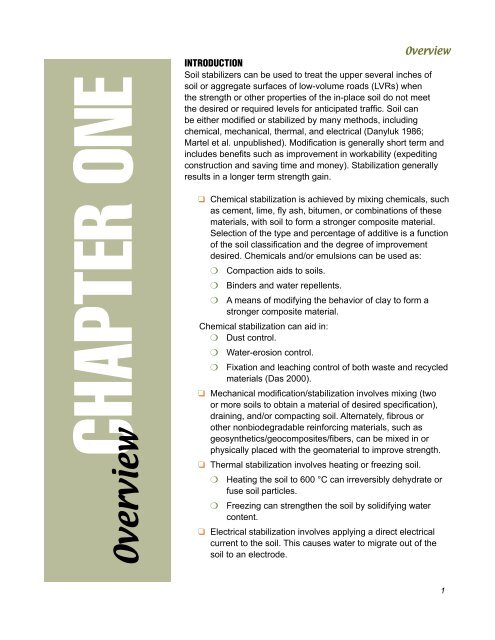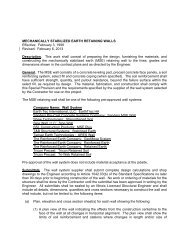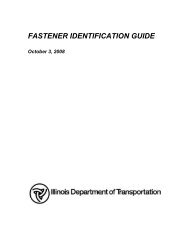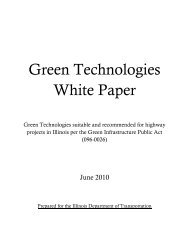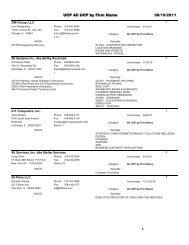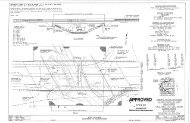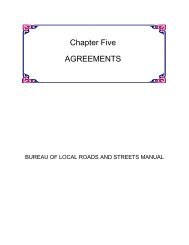Stabilization Selection Guide for Aggregate - Illinois Department of ...
Stabilization Selection Guide for Aggregate - Illinois Department of ...
Stabilization Selection Guide for Aggregate - Illinois Department of ...
Create successful ePaper yourself
Turn your PDF publications into a flip-book with our unique Google optimized e-Paper software.
CHAPTER ONE<br />
Overview<br />
Overview<br />
INTROdUCTION<br />
Soil stabilizers can be used to treat the upper several inches <strong>of</strong><br />
soil or aggregate surfaces <strong>of</strong> low-volume roads (LVRs) when<br />
the strength or other properties <strong>of</strong> the in-place soil do not meet<br />
the desired or required levels <strong>for</strong> anticipated traffic. Soil can<br />
be either modified or stabilized by many methods, including<br />
chemical, mechanical, thermal, and electrical (Danyluk 1986;<br />
Martel et al. unpublished). Modification is generally short term and<br />
includes benefits such as improvement in workability (expediting<br />
construction and saving time and money). <strong>Stabilization</strong> generally<br />
results in a longer term strength gain.<br />
q Chemical stabilization is achieved by mixing chemicals, such<br />
as cement, lime, fly ash, bitumen, or combinations <strong>of</strong> these<br />
materials, with soil to <strong>for</strong>m a stronger composite material.<br />
<strong>Selection</strong> <strong>of</strong> the type and percentage <strong>of</strong> additive is a function<br />
<strong>of</strong> the soil classification and the degree <strong>of</strong> improvement<br />
desired. Chemicals and/or emulsions can be used as:<br />
m Compaction aids to soils.<br />
m Binders and water repellents.<br />
m A means <strong>of</strong> modifying the behavior <strong>of</strong> clay to <strong>for</strong>m a<br />
stronger composite material.<br />
Chemical stabilization can aid in:<br />
m Dust control.<br />
m Water-erosion control.<br />
m Fixation and leaching control <strong>of</strong> both waste and recycled<br />
materials (Das 2000).<br />
q Mechanical modification/stabilization involves mixing (two<br />
or more soils to obtain a material <strong>of</strong> desired specification),<br />
draining, and/or compacting soil. Alternately, fibrous or<br />
other nonbiodegradable rein<strong>for</strong>cing materials, such as<br />
geosynthetics/geocomposites/fibers, can be mixed in or<br />
physically placed with the geomaterial to improve strength.<br />
q Thermal stabilization involves heating or freezing soil.<br />
m Heating the soil to 600 °C can irreversibly dehydrate or<br />
fuse soil particles.<br />
m Freezing can strengthen the soil by solidifying water<br />
content.<br />
q Electrical stabilization involves applying a direct electrical<br />
current to the soil. This causes water to migrate out <strong>of</strong> the<br />
soil to an electrode.<br />
1


